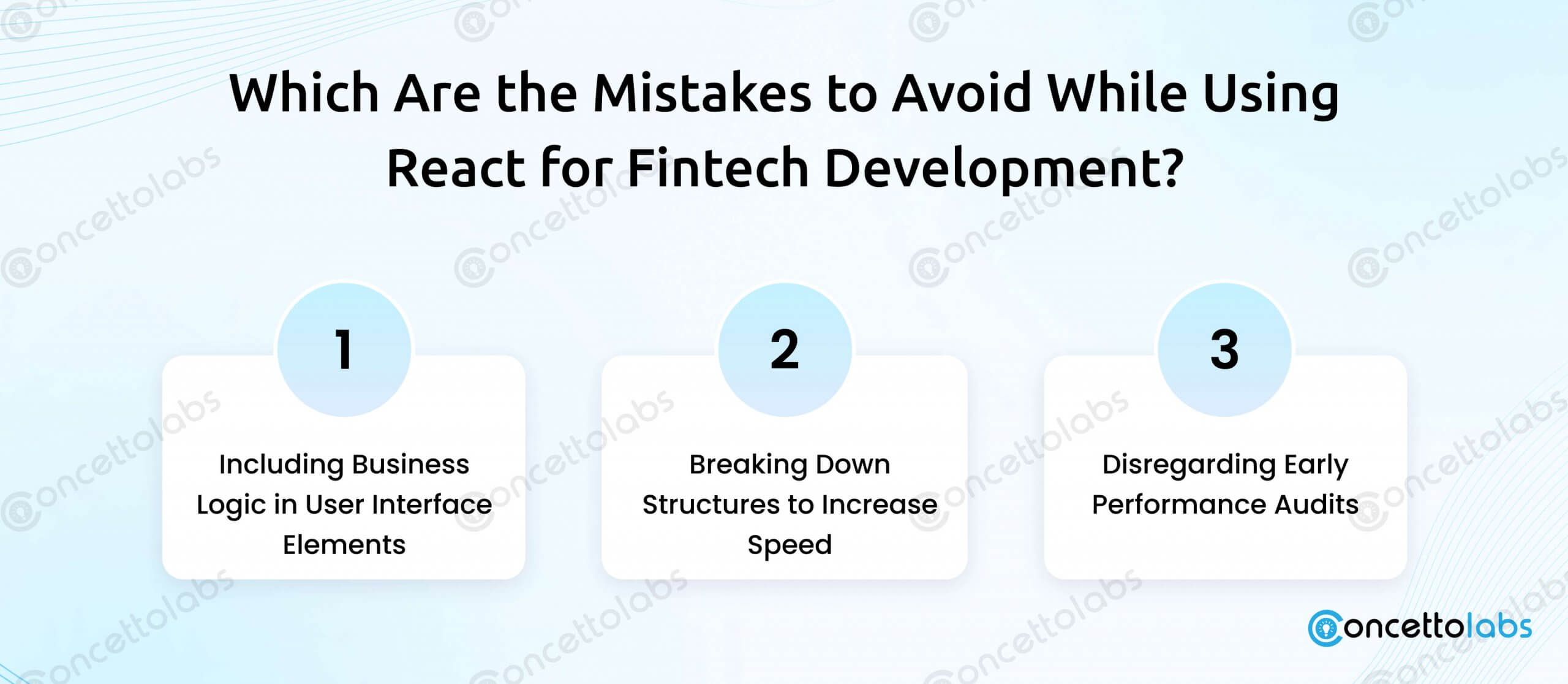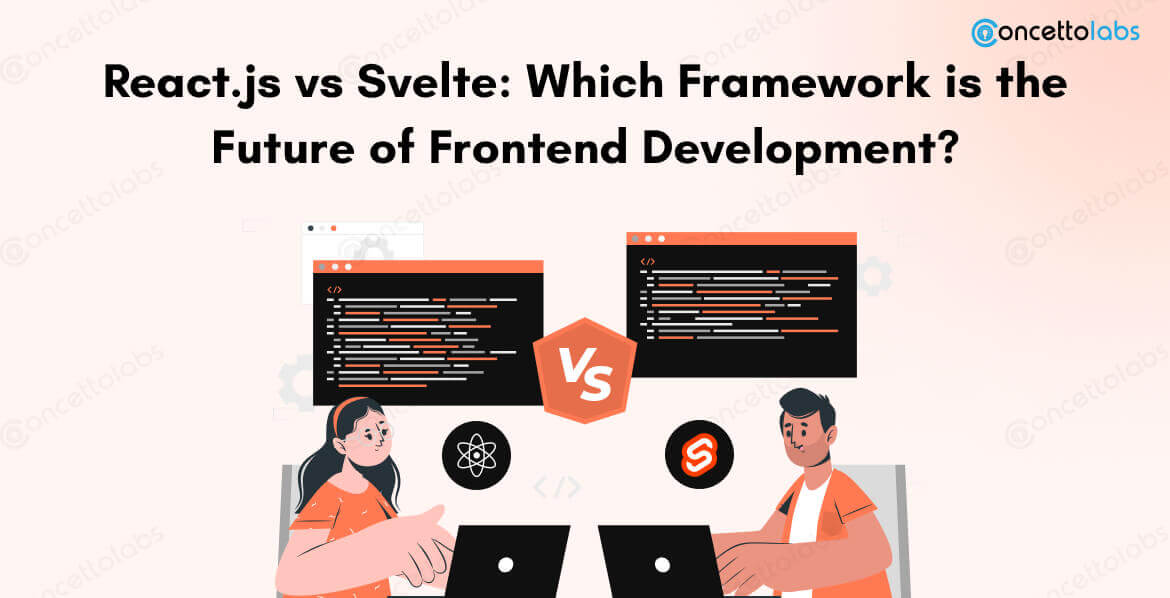
Summary: Do you want to develop a fintech app in react? React for Fintech is the best choice because of its flexibility, scalability, and security. The 8 professional expert tips from Concetto Labs can help developers and organizations use React development services to build finance platforms that are stable, easy to use, and able to grow with modern Fintech needs.
Fintech is the present, not just the future. From online banking and mobile wallets to investing platforms and online insurance, fintech is transforming traditional financial networks with innovative, effective, and useful solutions. Given that the financial sector is expected to grow to $699.5 billion by 2030, it is imperative that React JS and React Native applications have front-end security.
In this high-stakes field, businesses are also embracing ReactJS more and more for finance apps to make sure that users have safe, responsive, and easy-to-use experiences. There is a growing need for safe and easy-to-use financial apps, therefore, it’s crucial to employ the right tech stack to make them work.
Concetto Labs, a trusted Fintech development company, assists startups and large corporations in utilizing React’s capabilities to develop Fintech solutions that are both scalable and user-friendly.
What is the Role & Importance of ReactJS in the Fintech Industry?
- Well-known fintech web development features include real-time updates and robust app user control. ReactJS development services are used to build these features.
- The Virtual DOM feature of the React framework helps to fix rendering issues that have previously occurred in Fintech applications.
- Additionally, ReactJS makes it much easier to simplify very complicated procedures, particularly when working with intricate financial dashboards and analytics.
- One unique feature of the component-based architecture that contributes to the productivity of an application is the ability of ReactJS developers to create reusable user interface elements.
What Are the 8 Proven Fintech Tips to Develop UIs Faster?

1. Prioritizing Security
In finance, security cannot be compromised. While using React JS development services for Fintech applications, it is necessary to adhere to strict security code guidelines.
Experts from Concetto Labs advise
- Sanitize inputs at all times to avoid XSS attacks.
- For all data transfers, use HTTPS.
- Put role-based access restriction and JWT authentication into practice.
- Never reveal keys on the front end, and keep private information safe.
Along with Helmet.js, we also set Content Security Policies (CSP) and secured HTTP headers. From the very beginning of development, a strong DevSecOps culture aids in creating safe React applications for Fintech.
2. Use TypeScript with React for Strong Typing
JavaScript is dynamic, and TypeScript adds static typing, which is essential for large, complex Fintech software development projects.
Applying TypeScript
- Runtime errors are reduced.
- It facilitates reading and maintaining your code.
- It gets easier to onboard new developers.
The React JS Fintech consulting team at Concetto Labs uses TypeScript extensively to build reliable apps that are more scalable and error-free.
3. Optimizing Performance with Loading & Code Splitting
Tools like React. lazy and React Suspense are available in the React ecosystem to reduce load speeds, which is essential for Fintech platforms where users need instant responsiveness.
For instance
- Components that are originally unnecessary should be lazy loaded.
- Use React Router’s dynamic import capability for route-based code splitting.
- Only include the landing page’s necessary scripts in the bundle.
This enhances user experience and performance, both of which are critical for mobile trading platforms and financial dashboards.
4. Use WebSockets to Integrate Real-Time Features
Providing real-time data updates, such as stock prices, exchange rates, or transaction notifications, is a crucial aspect of Fintech web development.
To provide real-time functionality
- Use React with WebSockets or libraries such as Socket.io.
- To handle states, combine with Zustand or Redux.
- Make sure you use the right error-handling and reconnection techniques.
React with Fintech apps that use real-time data have an advantage over their competitors in terms of user satisfaction and trust.
5. Implement Modular Architecture
A modular folder structure aids in the effective management of elements such as transactions, reporting, KYC, and user management for large-scale Fintech software development.
What Concetto Labs suggests
- Folder structure based on features.
- Maintaining testable, functional, and compact components.
- Use shared services and custom hooks to reuse logic.
A modular codebase also makes feature testing and team cooperation easier.
6. Leverage Third-Party Libraries Smartly
Even if there are many libraries in the React ecosystem, your project may get bloated if you incorporate them carelessly.
The experts at Concetto Labs recommend
- Use React Hook Form for secure and validated forms.
- Choose D3.js or Recharts for attractive financial data visualization.
- Verify that every library is regularly updated and compatible with React.
It is best practice to routinely verify third-party dependencies for vulnerabilities, especially in sensitive Fintech app development situations.
7. Create with Compliance and Accessibility in Mind
Applications for financial aid must be inclusive and adhere to legal requirements such as WCAG or the ADA.
When developing the React frontend for Fintech platforms
- Make use of ARIA roles and semantic HTML.
- Make that the keyboard navigation functions properly.
- Use colour-contrast tools and screen readers to test.
Fintech software development relies heavily on usability and trust, which are enhanced by an accessible user interface.
8. Choose the Right Development Partner
An exceptional Fintech application requires domain knowledge, design thinking, strategy, and compliance.
Concetto Labs React experts can assist in
- We offer professional React JS programming services to the finance sector.
- Our team is aware of the cost constraints, security needs, and performance expectations.
- From inception to launch, our React JS Fintech consulting ensures that your project is prepared for the market.
If you are looking to hire ReactJS developers with proven Fintech web development experience, Concetto Labs is ready to assist you in achieving your objective.
Which are the Mistakes to Avoid while using React for Fintech Development?

Despite the speed, flexibility, and modularity that React for Fintech offers, small implementation or architectural errors could later cause serious problems. When best practices were neglected in the haste to launch, we have witnessed teams suffer preventable failures.
Below are the three typical errors that businesses make when utilizing React in Fintech, along with tips on how to avoid them.
1. Including Business Logic in User Interface Elements
When user roles, validation logic, or financial rules are included directly into user interface elements, update bottlenecks are produced. Custom hooks, utilities, or service layers are the best places to store logic. Readability, test coverage, and future scalability are all enhanced by this division.
2. Breaking Down Structures to Increase Speed
Hastily launching MVPs frequently leads to naming conventions, imprecise data boundaries, and inconsistent folder structures. These quick cuts impede future product updates, slow onboarding, and disrupt testing. Having clear requirements from the start reduces friction as an architecture grows.
3. Disregarding Early Performance Audits
Reliable and responsive interfaces are preferred by fintech users. In early ages, neglecting frontend performance results in bloated dashboards, sluggish interactions, and irate users. A consistent experience across devices and geographical locations is ensured by routine checks for size, load time, and memory usage.
How Concetto Labs Used ReactJS to Launch a Scalable Fintech Platform?
Our ReactJS specialists have assisted fintech businesses in neo-banking, wealth management, and digital lending in delivering scalable, safe, and high-performing systems. The Challenges that All Fintech app development projects face are:
Across more than 25 fintech engagements, we investigated the most pertinent recurring frontend challenges that impacted user experience, prolonged time-to-market, and created friction related to scale:
- Monolithic or outdated frontend stacks that result in disjointed user interface procedures for onboarding, loans, payments, and approvals.
- Delays in reflecting credit ratings, payments, and approvals were caused by poor real-time responsiveness.
- It is challenging to integrate regular regulatory updates without making the software unstable.
- Agents, borrowers, and administrators have poor user experience and security flaws as a result of ineffective role-based access.
- High ramp-up time for novice developers as a result of a frontend architecture that is opaque or inconsistent.
How Did We Use ReactJS to Address These Issues?
1. Architecture with Components
To accommodate dynamic forms, onboarding flows, dashboards, and approval modals, we reorganized user interfaces into modular, reusable React components. As a result, there was less code duplication and a uniform user experience across modules.
2. Integration of Real-Time Data
We removed the need for full-page reloads by combining React Query, WebSockets, and polling methods to enable real-time updates for EMIs, KYC approvals, account changes, and ticketing.
3. Compliant-Ready Development
To guarantee that compliance modifications could be made without disrupting unrelated UI elements, our team used layered design and bespoke React hooks to isolate business logic.
4. Routing Based on Roles
We were able to securely and effectively customize views and actions for borrowers, agents, underwriters, and compliance officials by combining dynamic routing with the React Context API.
5. Codebase Friendly Developers
Cross-team cooperation and quick onboarding were made possible by standardized folder structures, clear concern separation, and scalable state management with Redux Toolkit or Context.
How Will Concetto Labs Assist with React for Fintech?
Fintech product development calls for more than just speed. Clarity, trust, and the ability to adapt when customer demands or compliance abruptly alter are necessary. Your frontend has a big impact on that stability, and React gives your team the tools they need to build it.
React reduces rework, increases productivity, and allows you to focus on flexibility and compliance when used correctly. As deadlines shorten and pressure mounts, it maintains the dependability of your product.
React needs more than just strong code to perform at this level, you also need a team that understands the risks associated with fintech development.
Reputable React js development company Concetto Labs has a wealth of experience building safe, scalable banking frontends that expedite product delivery without sacrificing quality or compliance.
Our React developers have worked with lending platforms, neobanks, and financial tools. We take care to develop UI solutions that complement your product vision, follow secure coding guidelines, and are built to scale and adapt.
Make use of Concetto Labs ReactJS knowledge to develop applications that are future-ready, scalable, and safe.Are you preparing to launch your upcoming Fintech React product?







 Indonesia
Indonesia
 Botswana
Botswana
 USA
USA
 Italy
Italy
 Panama
Panama




 USA
USA UK
UK Saudi Arabia
Saudi Arabia Norway
Norway India
India Australia
Australia